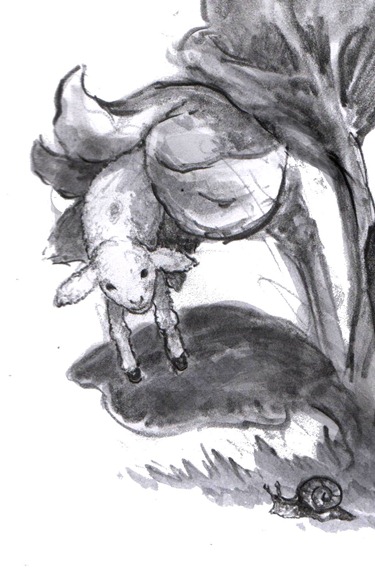For in his path he sees a monstrous birth,
The Borametz arises from the earth
Upon a stalk is fixed a living brute,
A rooted plant bears quadruped for fruit,
…It is an animal that sleeps by day
And wakes at night, though rooted in the ground,
To feed on grass within its reach around.– Dr. De la Croix, in Connubia Florum, Latino Carmine Demonstrata (1791)
This plant bears a crop of cute little lambs. It is therefore the go-to fruit tree for hungry wolves. Sadly, in order to survive, the lambs need to remain attached to the umbilical stems of the plant and this means that, once they have nibbled away all the grass within reach, they starve to death. It’s an unfortunate and fleeting existence, belonging to one of the most absurd creatures ever invented.
The Vegetable Lamb’s Wikipedia entry suggests that the Golden Chicken Fern may have provided the basis for the Barometz, but I expect that this one is just too far-fetched to have any grounding in reality.
In the splendid book Beasts! Kaela Graham contributed a fantastic illustration of the Barometz. Also check out his unpublished version.
If you haven’t got Beasts! or Beasts! Book Two, I’d highly recommend that you rectify the situation. They’re collections of, well, beasts, as depicted by various comic book artists and collected by Jacob Covey for Fantagraphics. Each picture comes at its subject from a fresh angle, and nothing is depicted in the way you might expect (the mermaid in the second volume springs to mind).
Jorge Luis Borges included the Barometz in his Book of Imaginary Beings, where he referenced other plants that behave like animals, namely a bird-eating plant imagined by G K Chesterton, the trees in Dante’s forest of self-murderers, and the crying mandrake, as recently seen in Guillermo Del Toro’s masterpiece, Pan’s Labyrinth (here shown relaxing between takes).
In the ocean there is a creature that really is a plant-animal hybrid. Whereas leaf insects, stick insects, and these fern-like creatures found in the Antarctic merely look like plants, the Green Sea Slug has performed the trick of the Barometz in reverse, and become part-vegetable.

